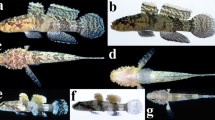Abstract
A gland in the tip of the tail of the garden eel (Heterocongridae) is described. This gland produces a mixture of neutral and, to a lesser extent, acidic mucopolysaccharides. These slime substances appear to be used to glue the sand grains forming the tube walls in which the semi-sedentary eels live. The structure of the gland is described in relation to the normal mucous-containing goblet cells in the body epidermis of the garden eels. In the tail of young individuals, in two species, only goblet-like cells could be found. These differ in shape and histochemical reaction from the tail gland of the adult eels.
Zusammenfassung
-
1.
Eine Schleimdrüse in der Schwanzspitze einiger Röhrenaale (Heterocongridae) wird beschrieben.
-
2.
Nach Verhaltensbeobachtungen kann angenommen werden, daß das Sekret dieser Drüse zur Verfestigung der Wohnröhrenwände dient.
-
3.
Die Schleimsubstanz besteht vorwiegend aus neutralen und zu einem geringen Anteil aus sauren Mucopolysacchariden.
-
4.
Die Drüsenzellen werden mit den Schleimzellen in der Haut der Körpermitte und mit denen der Schwanzspitze der Jungtiere zweier Arten verglichen.
Similar content being viewed by others
Zitierte Literatur
Bath, H.: Über die Körperhaut des Röhrenaales Xarifania hassi. Z. Zellforsch. mikrosk. Anat. 51, 728–734 (1960).
Bauchot, M. L. et J. M. Bassot: Sur Heteroconger longissimus Günther et quelques aspects de sa biologie. Bull. Mus. natn. Hist. nat., Paris 30 (3), 258–261 (1958).
Fricke, H. W.: Biologie et comportement de Gorgasia sillneri (Klausewitz) et Taenioconger hassi (Klausewitz, Eibl-Eibesfeldt) (Téléostéen). C. r. hebd. Séanc. Acad. Sci., Paris 269, 1678–1680 (1969).
—: Ökologische und verhaltensbiologische Beobachtungen an den Röhrenaalen Gorgasia sillneri und Taenioconger hassi (Pisces, Apodes, Heterocongridae). Z. Tierpsychol. 27, p. 1076 (1970a).
Fricke, H. W.: Gorgasia sillneri (Heterocongridae), Nahrungserwerb und Befestigen der Wohnröhre. Film E 1712 der Encyclopaedia Cinematographica Göttingen 1970b.
Klausewitz, W. und I. Eibl-Eibesfeldt: Neue Röhrenaale aus den Maleviden und Nicobaren. Senckenberg. biol. 40, 135–153 (1959).
McManus, J. F. A.: Histological and histochemical uses of periodic acid. Stain Technol. 23, 99–108 (1948).
Pearse, A. G. E.: Histochemistry, theoretical and applied, Vol. 1, 759, pp. London: Churchill 1968.
Romeis, B.: Mikroskopische Technik, 757 pp. München-Wien: R. Oldenburg Verlag 1968.
Spicer, S. S.: A correlative study of the histochemical properties of rodent acid mucopolysaccharides. J. Histochem. Cytochem. 8, 18–34 (1960).
Author information
Authors and Affiliations
Rights and permissions
About this article
Cite this article
Gasimir, M.J., Fricke, H.W. Zur funktion, morphologie und histochemie der Schwanzdrüse bei Röhrenaalen (Pisces, Apodes, Heterocongridae). Mar. Biol. 9, 339–346 (1971). https://doi.org/10.1007/BF00372828
Accepted:
Issue Date:
DOI: https://doi.org/10.1007/BF00372828




